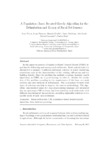A population-based iterated greedy algorithm for the delimitation and zoning of rural settlements

Use este enlace para citar
http://hdl.handle.net/2183/20938
A non ser que se indique outra cousa, a licenza do ítem descríbese como Atribución-NoComercial-SinDerivadas 3.0 España
Coleccións
- Investigación (FIC) [1678]
Metadatos
Mostrar o rexistro completo do ítemTítulo
A population-based iterated greedy algorithm for the delimitation and zoning of rural settlementsAutor(es)
Data
2013Cita bibliográfica
Porta, J., Parapar, J., Doallo, R., Barbosa, V., Santé, I., Crecente, R., & Díaz, C. (2013). A population-based iterated greedy algorithm for the delimitation and zoning of rural settlements. Computers, Environment and Urban Systems, 39, 12-26.
Resumo
[Abstract] In this paper we present a Population-Based Iterated Greedy (PBIG) algorithm for delimiting and zoning rural settlements. Each cadastral plots is allocated to a category (traditional–historical, common or none) considering restrictions such as the characteristics of the existing edifications and the building density. Since the problem has multiple solutions, heuristic search algorithms, as PBIG, are a good strategy to solve it. Besides the resolution of the problem according to the requirements of the laws, our work explores also new methods of delimitation. The comparison between both types of solutions can help to improve the current methodology. The algorithm, implemented using the Java programming language and integrated into an open-source GIS software, has been tested in rural settlements with different morphological characteristics, providing adjustable solutions to the specific needs of each rural settlement.
Palabras chave
Rural settlements
GIS
Population based iterated greedy algorithm
Java
GIS
Population based iterated greedy algorithm
Java
Versión do editor
Dereitos
Atribución-NoComercial-SinDerivadas 3.0 España
ISSN
0198-9715
1873-7587
1873-7587






